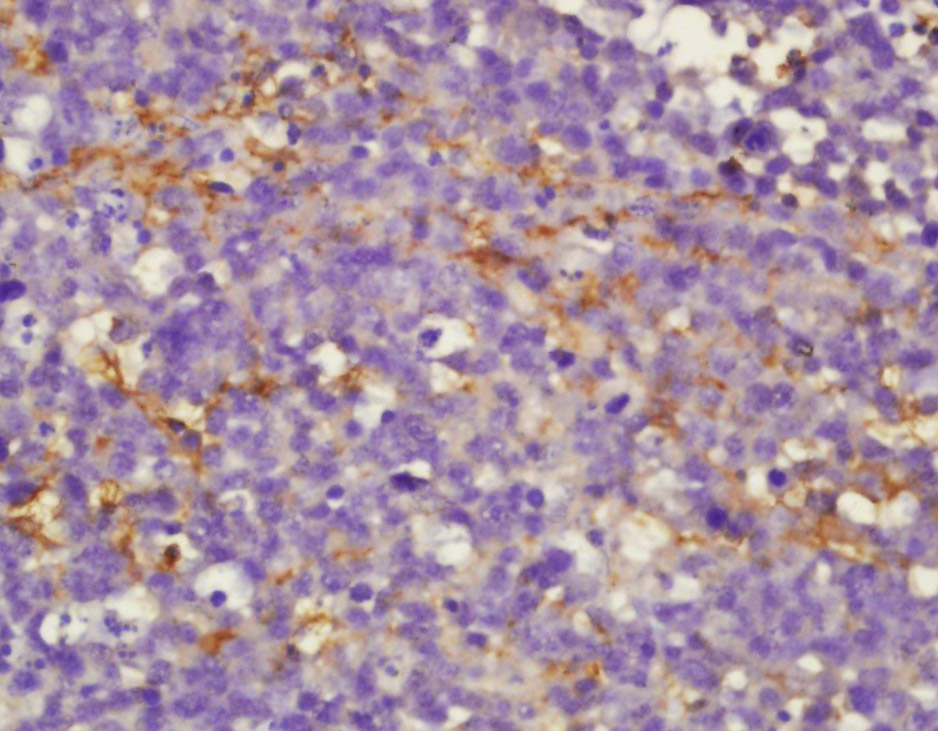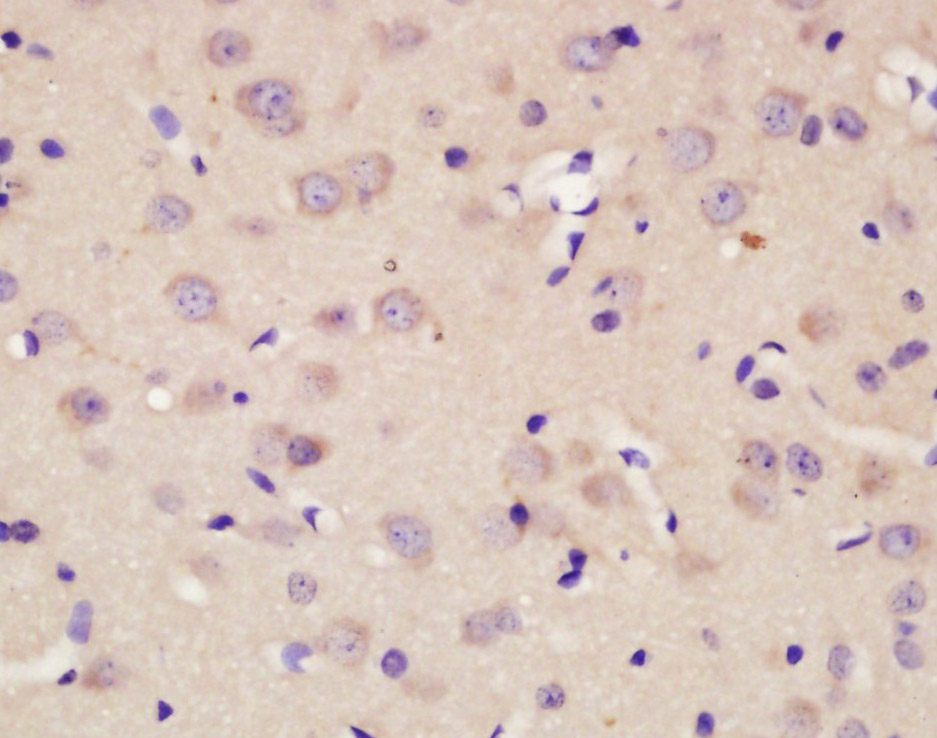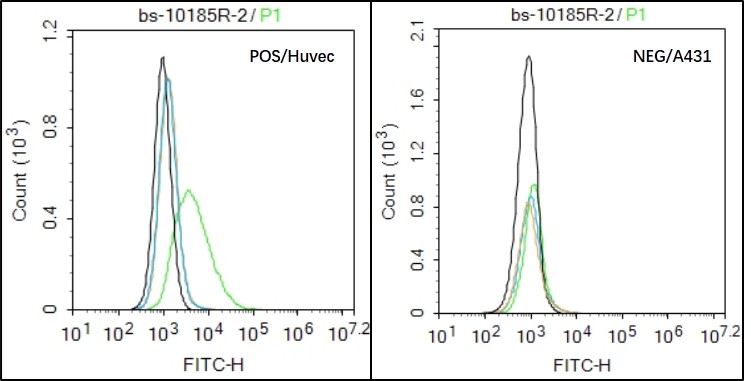
Rabbit Anti-CMKLR1 antibody
Chemokine receptor-like 1; CHEMR23; ChemR23; DEZ; Chemokine like receptor 1; G protein coupled receptor ChemR23; G protein coupled receptor DEZ; CML1_HUMAN ; Orphan G protein coupled receptor.
View History [Clear]
Details
Product Name CMKLR1 Chinese Name 趋化样因子受体1抗体 Alias Chemokine receptor-like 1; CHEMR23; ChemR23; DEZ; Chemokine like receptor 1; G protein coupled receptor ChemR23; G protein coupled receptor DEZ; CML1_HUMAN ; Orphan G protein coupled receptor. literatures Research Area Tumour Cell biology Chromatin and nuclear signals G protein-coupled receptor Epigenetics G protein signal Immunogen Species Rabbit Clonality Polyclonal React Species Human, Rat, (predicted: Mouse, ) Applications ELISA=1:5000-10000 IHC-P=1:100-500 IHC-F=1:100-500 Flow-Cyt=2μg/Test ICC=1:100-500 IF=1:100-500 (Paraffin sections need antigen repair)
not yet tested in other applications.
optimal dilutions/concentrations should be determined by the end user.Theoretical molecular weight 42kDa Cellular localization The cell membrane Form Liquid Concentration 1mg/ml immunogen KLH conjugated synthetic peptide derived from rat CMKLR1: 151-250/371 <Extracellular> Lsotype IgG Purification affinity purified by Protein A Buffer Solution 0.01M TBS(pH7.4) with 1% BSA, 0.03% Proclin300 and 50% Glycerol. Storage Shipped at 4℃. Store at -20 °C for one year. Avoid repeated freeze/thaw cycles. Attention This product as supplied is intended for research use only, not for use in human, therapeutic or diagnostic applications. PubMed PubMed Product Detail Chemokine-Like Receptor 1 (CMKLR1) is a serpentine transmembrane G-protein linked receptor. It is an orphan chemoattractant receptor, also known as ChemR23 or DEZ. CMKLR1 is expressed on the surface of monocyte-derived immature dendritic cells and peripheral plamacytoid dendritic (pDC) cells; but not on myeloid dendritic (mDC) cells, monocytes and lymphocytes. The expression of CMKLR1 on pDC is down-regulated after activation. Chemerin (TIG2) is a natural ligand of CMKLR1. The interaction of CMKLR1 with Chemerin induces pDC activation and chemotaxis. It has been shown that CMKLR1 is a coreceptor for several strains of SIV and HIV-1. CMKLR1 is a potential useful marker for distinguishing pDCs and mDCs.
Function:
Receptor for the chemoattractant adipokine chemerin/RARRES2 and for the omega-3 fatty acid derived molecule resolvin E1. Interaction with RARRES2 induces activation of intracellular signaling molecules, such as SKY, MAPK1/3 (ERK1/2), MAPK14/P38MAPK and PI3K leading to multifunctional effects, like, reduction of immune responses, enhancing of adipogenesis and angionesis. Resolvin E1 down-regulates cytokine production in macrophages by reducing the activation of MAPK1/3 (ERK1/2) and NF-kappa-B. Acts as a coreceptor for several SIV strains (SIVMAC316, SIVMAC239, SIVMACL7E-FR and SIVSM62A), as well as a primary HIV-1 strain (92UG024-2).
Subcellular Location:
Cell membrane.
Tissue Specificity:
Prominently expressed in developing osseous and cartilaginous tissue. Also found in adult parathyroid glands. Prominently expressed in developing osseous and cartilaginous tissue. Also found in adult parathyroid glands. Expressed in cardiovascular system, brain, kidney, gastrointestinal tissues and myeloid tissues. Expressed in a broad array of tissues associated with hematopoietic and immune function including, spleen, thymus, appendix, lymph node, bone marrow and fetal liver. Among leukocyte populations abundant expression in monocyte-derived macrophage and immature dendritic cells (DCs). High expression in blood monocytes and low levels in polymorphonuclear cells and T cells. Expressed on endothelial cells.
Similarity:
Belongs to the G-protein coupled receptor 1 family.
SWISS:
Q99788
Gene ID:
1240
Database links:Entrez Gene: 1240 Human
Entrez Gene: 14747 Mouse
Omim: 602351 Human
SwissProt: Q99788 Human
SwissProt: P97468 Mouse
Unigene: 197143 Human
Unigene: 5196 Mouse
Product Picture
Antigen retrieval: citrate buffer ( 0.01M, pH 6.0 ), Boiling bathing for 15min; Block endogenous peroxidase by 3% Hydrogen peroxide for 30min; Blocking buffer (normal goat serum,C-0005) at 37℃ for 20 min;
Incubation: Anti-CMKLR1 Polyclonal Antibody, Unconjugated(SL10185R) 1:200, overnight at 4°C, followed by conjugation to the secondary antibody(SP-0023) and DAB(C-0010) staining
Tissue/cell: rat brain tissue; 4% Paraformaldehyde-fixed and paraffin-embedded;
Antigen retrieval: citrate buffer ( 0.01M, pH 6.0 ), Boiling bathing for 15min; Block endogenous peroxidase by 3% Hydrogen peroxide for 30min; Blocking buffer (normal goat serum,C-0005) at 37℃ for 20 min;
Incubation: Anti-CMKLR1 Polyclonal Antibody, Unconjugated(SL10185R) 1:200, overnight at 4°C, followed by conjugation to the secondary antibody(SP-0023) and DAB(C-0010) staining
Black line : Positive blank control HUVEC); Negative blank control (A431)
Green line : Primary Antibody (Rabbit Anti-CMKLR1 antibody (SL10185R) )
Orange line:Isotype Control Antibody (Rabbit IgG) .
Blue line : Secondary Antibody (Goat anti-rabbit IgG-AF488)
HUVEC(Positive)and A431(Negative control)cells (black) were incubated in 5% BSA blocking buffer for 30 min at room temperature. Cells were then stained with CMKLR1 Antibody(SL10185R)at 1:50 dilution in blocking buffer and incubated for 30 min at room temperature, washed twice with 2% BSA in PBS, followed by secondary antibody(blue) incubation for 40 min at room temperature. Acquisitions of 20,000 events were performed. Cells stained with primary antibody (green), and isotype control (orange).
Partial purchase records(bought amounts latest0)
No one bought this product
User Comment(Total0User Comment Num)
- No comment





 +86 571 56623320
+86 571 56623320




